Foreign Exchange Settlement Practices in Australia 3. Settlement Practices in the Australian Foreign Exchange Market
December 1997
Download the complete Report 269KB
3.1 Currencies
During April 1997, dealers participating in the survey reported foreign exchange settlements in 51 currencies. A complete list of currencies, together with the number of traders per currency, can be found in Annex C of this report. All respondents indicated that they had settled transactions in AUD, USD, JPY and NZD, while only one or two respondents had not settled transactions in DEM, GBP, CHF or CAD. Other currencies settled by many respondents included the FRF, ITL, HKD and SGD.
When measured in terms of value, USD and AUD settlements dominated, accounting for roughly three quarters of all foreign exchange activity in Australia.[1] The USD represented almost half of total payments and receipts, indicating that it is on one side of virtually all foreign exchange transactions in the Australian market. When settlements in DEM, JPY, NZD and GBP are added to those in AUD and USD, these six currencies accounted for approximately 95 per cent of the value of all foreign exchange transactions for the month.
The average daily values of transactions in all other currencies were much smaller than those recorded for the six most actively traded currencies. However, the value of an individual transaction in one of these currencies, on any given day, could be large, and it should not be assumed that foreign exchange settlement risk is only an issue for the six most actively traded currencies.
3.2 Settlement methods
For most currencies, foreign exchange payments and receipts were made principally through the use of a nostro account held with another (correspondent) bank. As shown in Annex C to this report, the use of an unrelated correspondent bank was the most common method of settling foreign exchange transactions in most of the major currencies. The GBP and AUD were the two exceptions to this rule. Settlements in GBP were made almost equally by: unrelated correspondent banks; related corporate entities (ie parent banks or subsidiaries); or through branches in the United Kingdom. In contrast, the majority of survey respondents were directly responsible for the settlement of AUD transactions. However, the use of local correspondent banking services, by both bank and non-bank dealers, was also evident. Interestingly, not all institutions using a domestic correspondent for settling AUD transactions used a correspondent that was itself a direct clearer; that is, the correspondent in turn sometimes used a correspondent to settle on its behalf.
Not surprisingly, the choice of a correspondent often appears related to ownership. When the use of a related correspondent bank (ie parent or subsidiary) was combined with direct participation in the relevant payments systems, the relative use of ‘external’ agents to make and receive foreign exchange payments declined appreciably. For most of the major traded currencies, there was a near-equal split in the proportion of foreign exchange business being settled ‘internally’ (ie either directly or by related corporate entities) and that which was handled ‘externally’ (ie by a correspondent that did not have a common ownership). The principal exceptions were the NZD, CHF, FRF and MYR, where the use of an unrelated correspondent bank far exceeded ‘internal’ settlements. One reason for this may be the relatively high levels of banking sector concentration – and therefore correspondent banking facilities – in these countries.
3.3 Duration of exposures
As noted above, the USD is on one side of most foreign exchange transactions in the Australian market; the only other currency pairings of note involve trading against the AUD and DEM. The duration of foreign exchange settlement risk for all currencies against the USD is presented in the tables forming Annex D of this report.
The times presented in Annex D represent the difference, in hours, between the weighted average time when a payment instruction in the sold currency can no longer be cancelled unilaterally and the weighted average time when a receipt in the bought currency is confirmed with finality (or has been identified as failed). The weights applied were derived from the value of payments and receipts supplied by survey respondents for each currency. As will be discussed later in this report, there were some very large deviations from these averages; the duration of foreign exchange settlement risk varied greatly between the institutions surveyed.
The results for the more significant currency pairs traded in the Australian market are reproduced in Table 1. This shows that there are significant variations in the duration of foreign exchange settlement risk, depending on whether a dealer is on the bid (buy) or offer (sell) side of the transaction.
| Currency pair | USD bought | USD sold |
|---|---|---|
| AUD/USD | 33 | 12 |
| USD/DEM | 31 | 22 |
| USD/JPY | 37 | 17 |
| NZD/USD | 37 | 18 |
| GBP/USD | 29 | 24 |
| USD/CHF | 32 | 30 |
| USD/FRF | 32 | 20 |
| USD/MYR | 35 | 27 |
| USD/SGD | 36 | 24 |
| USD/HKD | 35 | 18 |
The length of foreign exchange settlement risk is generally shorter for transactions where the USD was sold, rather than where the USD was bought. The differences in the time at risk can be substantial – for example, on an AUD/USD transaction, it was over 21 hours. The weighted average exposures generated by each of the five major pairs traded in the Australian market are illustrated below in Diagrams 2 and 3.
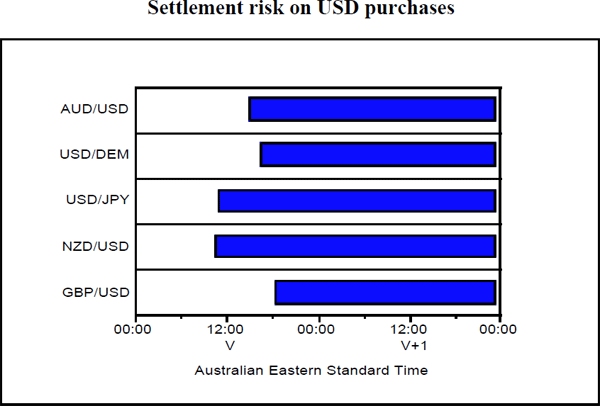
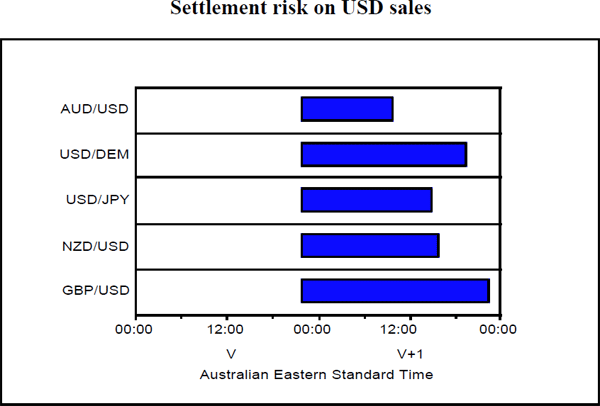
Time zone differences play a major part in explaining these differences. Where currencies have been sold for USD, payment is generally required before the US payments system opens for the corresponding receipts. Where USD have been sold, the payment instruction can generally be cancelled later in the Australian day than can those for Asian or European currencies. Conversely, receipts in most currencies can generally be confirmed earlier than those in USD.
For some currencies with deferred net settlement arrangements – most notably the AUD and NZD – many respondents indicated that they reconcile receipts before interbank settlement has been completed across the accounts of the respective central banks. While early reconciliation assists in the detection of payments that have definitely not been received (ie those with Status F), it under-estimates the length of time that a dealer has an exposure to foreign exchange settlement risk.
Dealers are exposed to the risk of not receiving final value from a payment instruction until settlement occurs at the central bank. In the absence of a real-time gross settlement (RTGS) system, that may be many hours, or even days, after the settling bank has issued the payment. All such payments have a Status U. Without RTGS, a failure to settle by any direct member of a clearing system, regardless of whether they were involved in the settlement of the transaction in question, could precipitate an unwinding of the clearings and jeopardise the final receipt of the currency bought, leading to the risk of a full loss of principal on the transaction (ie the amount already delivered).
3.4 Magnitude of exposures
During the month of April, the 24 survey respondents collectively made foreign exchange payments for their own account worth, on average, $A122 billion each day. This figure represents the sum total of one side of all foreign exchange transactions; consequently, the respondents also received, on average, approximately $A122 billion per day from the settlement of foreign exchange related transactions.
It should be noted that the survey sought information on gross, not netted, amounts. As discussed later in Section 5.3.2 of this report, most respondents indicated that they engage in some form of netting for foreign exchange settlements, despite the current legal uncertainty surrounding this practice. While the recording of gross amounts may overstate the amount at risk, this would not invalidate the broad magnitudes, particularly in the absence of legal certainty for netting.
As noted previously, the bulk of foreign exchange settlements in the Australian market is concentrated in just six currencies; this is shown clearly by Diagram 4.
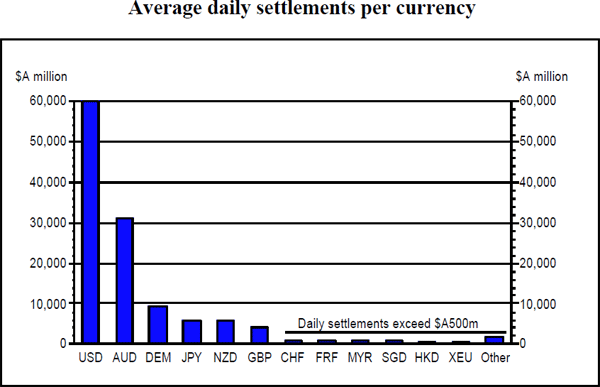
The USD is by far the major currency traded in the Australian market, accounting for $A60 billion in foreign exchange payments each day and another $A60 billion in receipts. As noted earlier, this represents roughly half of total reported settlements, implying that no significant cross-rate trading occurs in the Australian market.
The AUD ranked second, accounting for one quarter of total foreign exchange payments, or approximately $A31 billion per day. This amount represents foreign exchange settlements from AUD trading by the survey respondents for their own account; it does not include any settlement activity originating from vostro accounts operated by Australian banks for their offshore correspondents.[2] To include AUD vostro payments in this analysis is not appropriate because Australian banks do not face foreign exchange settlement risk on these transactions – they are only acting as an agent for their customers in making and receiving payments in AUD. Generally, they have no commercial interest in the final settlement of the foreign currency leg.
Of the four other most actively traded currencies, average payments per day were $A9.5 billion for DEM, $A5.7 billion for JPY, $A5.6 billion for NZD and $A4.2 billion for GBP. In addition, there were a further six currencies where average daily settlements in each currency ranged from $A500 million to just under $A1 billion.
3.5 Benchmarking exposures
For most respondents, and certainly on an industry basis, the values flowing from foreign exchange settlements are extremely large. Accordingly, some comparison, or benchmark, was sought in order to put the amounts into perspective. The benchmark chosen was capital.
Regulatory capital is not required to be held against foreign exchange settlement exposures; nor will it be under the market risk capital requirements (although capital will be required to be held against exchange rate risk, from the time that the transaction is entered into until settlement). Nevertheless, it is capital that must ultimately absorb losses arising out of the failure of a counterparty to pay.
Many of the institutions surveyed are part of multinational organisations that operate globally, with global capital. In those cases, it has been necessary to create a proxy for Australian capital for the purpose of these calculations. The capital used in this study to benchmark the collective exposure of the 24 respondents was $A43 billion.
3.6 Industry risk profiles
The following section presents an analysis of the risk profile for the Australian foreign exchange market, based upon the trading patterns of respondents, the values settled and the reconciliation practices employed. Two aspects should be noted: first, it must be stressed that the times quoted below are industry weighted averages and do not necessarily correspond with any actual time reported by individual respondents. The use of weighted average measurements is consistent with the CPSS methodology. Second, the settlement amounts reported are those supplied by respondents. There are reservations about the accuracy of some of these values but, in aggregate, they appear to be ‘in the ball park’.
It should also be noted that the methodology used in this report differs from that used to report foreign exchange turnover for the RBA's monthly Bulletin. The latter does not require the second leg of foreign exchange swaps to be reported. Both legs of a foreign exchange swap are generally settled and are therefore subject to settlement risk, in much the same way as are outright spot or forward transactions. This report takes account of the reciprocal leg of foreign exchange swaps that were settled during April 1997.
3.6.1 The one-day industry profile
Excluding the ‘exotic’ currencies, the weighted average exposure for a single day's foreign exchange transactions was around 84 hours (or 3 1/2 business days). This is consistent with the broad findings of the CPSS for the G10 banks in 1995. The maximum weighted average period of risk for the six most actively traded currencies in Australia is 37 hours (or 1 1/2 business days). The 37 hour period corresponds to the time that a dealer is at risk when selling either NZD or JPY for USD (refer to Table 1 and Diagram 2 above); the other actively traded currency pairs fall within this period. It should be noted, however, that Australian foreign exchange dealers can be exposed to settlement risk on a single day's transactions for a maximum of 746 hours (or 31 business days) due to receipts in some of the exotic currencies being reconciled only once per month. Settlements in these currencies are not generally of a significant value.
The accumulation of foreign exchange settlement risk beyond a 24 hour period has some important implications. Diagram 5 illustrates the pattern of risk accumulation, and subsequent reduction, for a single day's foreign exchange transactions, based on data collected from the survey. The capital benchmark, discussed in Section 3.5 above, is also shown.
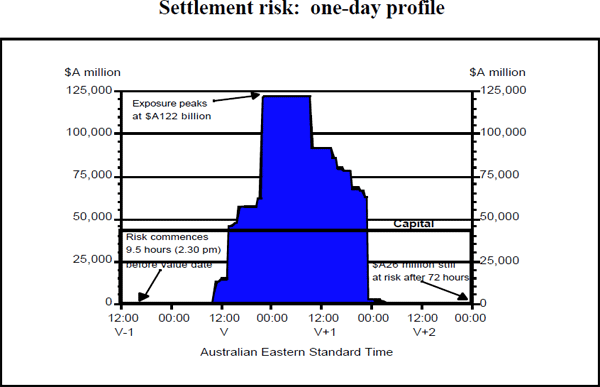
As shown above, settlement risk on some foreign exchange transactions – in this instance, on sales of IDR – commences some 9 1/2 hours before the actual value date. Thus, from 2.30 pm on the day before value date (denoted ‘V−1’), Australian dealers are exposed to $A350 million of foreign exchange settlement risk on an average day. The accumulated exposure increases incrementally during the early morning as instructions to pay in other currencies become irrevocable, but the total values at risk do not become noticeable until mid-morning on value date, when over $A11 billion worth of payment instructions in NZD and JPY can no longer be cancelled. Instructions to pay in many of the Asian currencies become irrevocable around midday, Sydney time, by which stage the aggregate value of foreign exchange settlement exposure has reached approximately $A14 billion.
The risk profile increases dramatically in the early afternoon, when AUD payment instructions become irrevocable – the total values at risk by this time are around $A45 billion. By the close of the Australian banking day at 5.00 pm, instructions to pay in many European currencies, including the DEM, can no longer be cancelled; total foreign exchange settlement risk at this point is $A57 billion. By 7.00 pm, payments in most of the remaining currencies, including the GBP, can no longer be stopped and total settlement risk stands at $A61 billion.
By the close of business in Sydney, it should be possible to make some reductions, albeit small, to the $A61 billion at risk by reconciling receipt of those currencies in the Asia-Pacific time zone that have already settled with finality. For example, the FEYCS payments system for JPY settles at the Bank of Japan at 4.00 pm AEST, allowing a potential reduction in foreign exchange settlement risk of some $A5.7 billion on an average day. Total settlement risk could be reduced further if some of the Asian currencies which are settled on a real-time basis, such as the HKD, were reconciled by the local close of business in Sydney.[3] Not one of the respondents to the survey reconciled these payments before the Australian market re-opened next morning.
Instructions to make payments in North American currencies do not become irrevocable until late in the Australian evening (9.00 pm for CAD and 10.00 pm for USD). The last currency where payment instructions become irrevocable is the ECU. By 10.30 pm AEST, foreign exchange settlement risk on a single day's transactions reaches its maximum of $A122 billion; this represents the gross total for the payment leg of all foreign exchange deals to be settled that day.
Using the weighted average reconciliation times, the total principal amount on all foreign exchange transactions then continues at risk for a period of 11 1/2 hours, from 10.30 pm until 10.00 am on the following morning, when the AUD receipts are confirmed as having been received with finality. Settlement risk on the previous day's transactions falls progressively during the business day, as foreign currency receipts are confirmed as having been received with finality. However, by the close of business on the day after value date (denoted ‘V+1’), the total amount from the previous day's transactions that is still at risk equals $A78 billion, with final receipts in several major currencies – including the USD, DEM and GBP – still unconfirmed.
It should be reiterated that this industry profile refers to the weighted average times for reconciling receipts – some respondents do actually reconcile payments in the major currencies on day V+1. Nevertheless, the weighted average time for confirming that the $A60 billion of USD receipts is no longer at risk is 11.30 pm on day V+1; the outstanding settlement risk at this time is $A2.6 billion. The total value at risk does not drop below $A1 billion until CHF receipts are confirmed at 3.30 am on day V+2. By the local opening of business on day V+2, around $A200 million of transactions due two days earlier are still at risk; this figure is substantially the same by the close of business at 5.00 pm. By 6.00 pm on day V+2, foreign exchange settlement exposure drops to $A26 million. The remaining receipts still at risk are in minor currencies, which can take anywhere from 3 to 31 business days after value date to confirm with finality.
3.6.2 The inter-day industry profile
The accumulation of settlement risk over the periods discussed above means that foreign exchange payments in some currencies on one day will become irrevocable before it is confirmed whether settlements due the previous day have, in fact, been received with finality. Thus, at any point in time, it is possible for foreign exchange transactions due up to three (or even more) business days previously to still be at risk of failure.
Diagram 6 illustrates the inter-day accumulation of risk for an average day's foreign exchange settlements, again with the capital benchmark shown.
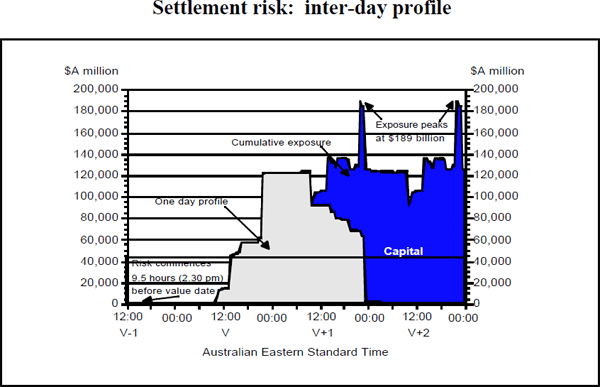
As with Diagram 5, foreign exchange settlement risk on a single day's transactions begins on day V−1 with the sale of IDR and plateaus at $A122 billion after instructions to pay ECU become irrevocable late on day V. However, due to the reconciliation times described above, settlement risk on the next day's foreign exchange transactions begins to accumulate before the risk on the previous day's deals has been extinguished. Thus, at any point in time, the value of more than one day's foreign exchange transactions is at risk of failure.
After foreign exchange settlement risk has accumulated on the first day's transactions, at no point in time thereafter does the total value at risk for the industry drop below $A92 billion. This is a significant on-going credit risk, representing a sum equivalent to the total daily value exchanged by Australian banks through the domestic payments system. And this is the minimum value at risk existing at any point in time.
The maximum amount of foreign exchange settlement risk, for an average day's transactions, is $A189 billion, which occurs late on day V+1 (and subsequently at the same time on day V+2, etc), lasting for 1 1/2 hours.[4] During this period, the second day's USD payments become irrevocable before the USD receipts due the preceding day are confirmed with finality. The peak amount of foreign exchange settlement risk represents over four times the capital benchmark discussed in Section 3.5 above.
The accumulation of risk does have important implications at the individual counterparty level, as well as at the more macro level discussed above. In setting and then monitoring settlement limits on individual counterparties, financial institutions must understand and be able to measure the duration of settlement risk. (Chapter 5 of this report reviews the questionnaire responses on risk management practices, including those relating to the setting and monitoring of limits.)
3.7 Industry benchmarks
The information presented above represents the collective exposure of survey respondents, on a weighted average basis, to foreign exchange settlement risk. However, individual practices did vary, often substantially, from this general industry profile. While no individual profiles are included in this report, the RBA has shown and discussed these results with most of the survey respondents.
The following section presents a composite of the ‘best’ and ‘worst’ industry settlement practices using the same values for an average day, but different cancellation and reconciliation times. It is worth noting that no single respondent exhibited the best (or worst) characteristics for all currencies surveyed.
3.7.1 Current best practice
‘Best practice’ refers to the combination of responses which produced the latest possible unilateral cancellation deadline, and earliest possible reconciliation deadline, for each currency.
An important caveat needs to be noted: for the purpose of this analysis, all responses which indicated that foreign exchange receipts were reconciled before the time of finality in each currency have been disregarded and the time of interbank settlement in the relevant currency has been substituted. As noted in Section 3.3, this was necessary to avoid under-estimating the duration of exposure to foreign exchange settlement risk. Thus, ‘best practice’ refers to what is actually being achieved (or has been assumed), not to what is theoretically possible.
If all survey respondents employed the current best practices in each currency, then the industry's collective exposure to foreign exchange settlement risk would look like Diagram 7.
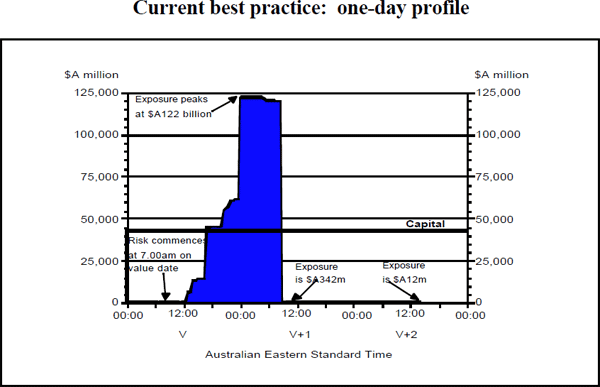
In common with Diagram 5 earlier, the maximum foreign exchange settlement exposure is equivalent to the day's total payments. However, unlike the weighted average case, the best practice case quarantines foreign exchange settlement risk on most currencies to a period of 40 hours – just over 1 1/2 business days. Furthermore, the risk does not start accumulating until the value date itself.
For the five most actively traded currency pairs in Australia, the maximum exposure is only 20 hours. This corresponds to the time that a dealer is at risk when selling NZD and buying USD. When current best practices are employed for some other major currency pairings, foreign exchange settlement exposure can be reduced to 12 hours (or even less).
Current best practices do not allow significant settlement exposures to accumulate across days. This is shown by Diagram 8.
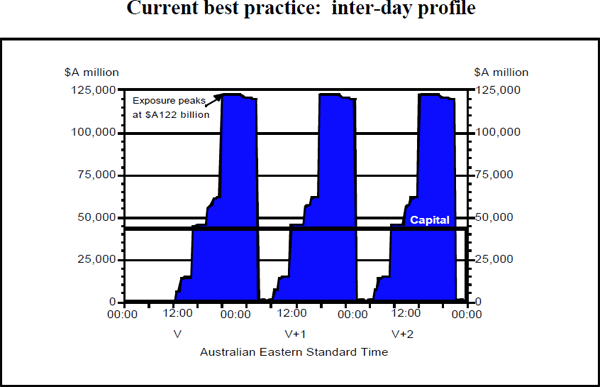
Even though current best practice does not allow settlement risk from one day's transactions to accumulate with that of the following day, it still falls short of what could be achieved. The maximum risk exhibited above in Diagram 8 is still the gross sum of all foreign exchange payments – the full principal amount settled each day. As noted in Section 3.6.1 above, there is no reconciliation on value date of currency receipts in Australia's time zone, such as the JPY and HKD, whose payments systems have settled. Over $A6 billion of risk, on these two currencies alone, could be removed if statements were reconciled at the end of the local day, rather than at a later date.
3.7.2 Current worst practice
‘Worst practice’ refers to the combination of responses which produced the earliest unilateral cancellation deadline, and latest reconciliation deadline, for each currency. For some currencies, receipts were reconciled only on a monthly basis; however, this was generally confined to the thinly traded exotic currencies. For some of the less exotic currencies, it was not uncommon for respondents to indicate that they were on a weekly statement cycle and therefore did not reconcile foreign exchange receipts for up to seven business days after value date.
Diagram 9 illustrates the exposure of the industry to foreign exchange settlement risk if the worst settlement practices observed were employed for payments and receipts in each currency.
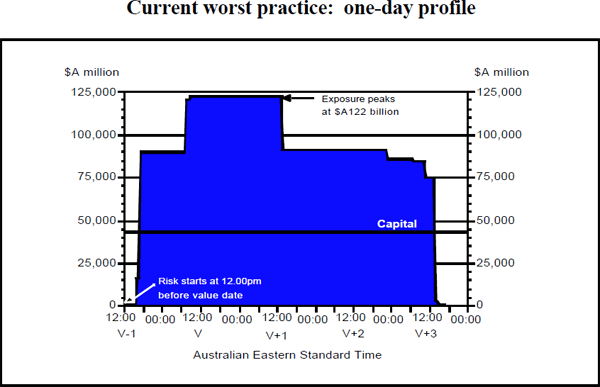
As shown above, if existing worst practices were the industry norm, then a substantial settlement exposure would have accumulated on the day before value date. By the start of the local business day in Sydney, less than $A20 million of the $A122 billion in foreign exchange payments due to be settled that day could be cancelled.
The length of time that the value of the entire day's settlements is at risk – some 29 hours – is also much longer than the weighted average case of 11 1/2 hours. The first noticeable drop in the aggregate value at risk does not occur until 2.00 pm on day V+1. This represents the latest time when AUD receipts are reconciled. However, after this, over $A90 billion of settlement exposure persists for another 33 hours before NZD receipts are confirmed. Total settlement risk remains in excess of $A80 billion for a further 12 hours before most of the major currencies are reconciled, and by the close of business on day V+3, just over $A300 million worth of payments in minor currencies are still at risk. It can take anywhere from 7 to 31 business days to confirm final receipts in these currencies.
The continuation of foreign exchange settlement exposure over three business days means that, at any one point in time, the total value at risk will be a multiple of a single day's foreign exchange transactions. Diagram 10 illustrates the inter-day accumulation of settlement risk if the current worst industry practices were employed for each currency.
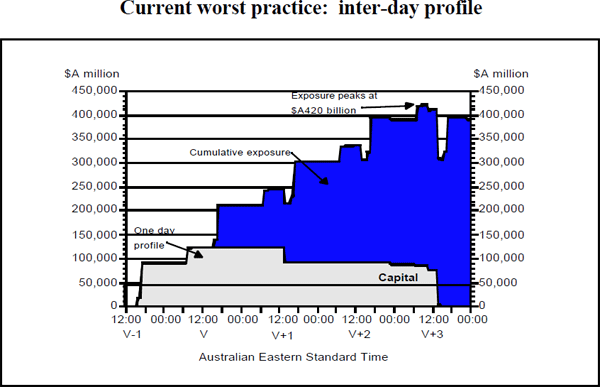
As shown above, the accumulation of foreign exchange settlement exposure is substantial. For the first 48-hour period, the total value at risk continues to increase without respite. By the close of business on day V+1, total settlement exposure equals $A245 billion – two days worth of foreign exchange payments. The late reconciliation time for the major traded currencies allows settlement risk to accumulate on additional days' transactions – by the close of business on day V+2, $A300 billion is at risk; by the close of day V+3, the value at risk is nearly $A400 billion. Total settlement risk peaks at just under $A420 billion, early in the morning of day V+3, and thereafter remains between $A300 billion and $A420 billion.
While such figures represent an extremity – an amalgamation of the worst possible settlement practices currently exhibited in the Australian market – it must be remembered that such practices do, in fact, exist and are based on responses from the dealers that were surveyed.
3.8 Analysis and discussion
3.8.1 Australian results
The results of the investigation into foreign exchange settlement risk in Australia are a concern. While several respondents are clearly aware of the issue and actively implementing strategies to reduce their exposures, many more are still obviously struggling to comprehend the spectrum of risks to which they are exposed when settling foreign exchange transactions.
The considerable difficulty that many respondents had in completing the questionnaire was quite surprising, yet also instructive. In subsequent discussions between the RBA and individual respondents, it was evident that many institutions simply did not have a good feel for the magnitudes of settlement risk to which they were exposed across their entire book. These exposures are significant – at the industry level, the on-going accumulated exposure ranges between $A92 billion and $A189 billion, well in excess of the capital available to absorb such losses.
Aggregating settlement risk across the entire book would appear, on the basis of this survey, to require financial institutions in Australia to broaden their focus on this risk. Saying that does not in any way diminish the advances of recent years as a growing number of financial institutions are now measuring, monitoring, setting and enforcing limits against settlement risk. The RBA, of course, supports and encourages that trend. But to date, at least in Australia, it has been done on a counterparty basis. What must be understood, though, is that foreign exchange settlement risk entails much more than risk to a single counterparty; in times of instability, it can rapidly escalate into systemic risk.
The RBA recognises the imponderables in attempting to anticipate or deal with a major systemic problem in the global banking system. Nevertheless, a crucial element in dealing with any banking problem, potential or real, is being able to quantify it, or at least being able to define its extremities. Accordingly, the RBA is of the view that Australian financial institutions should be able to measure and monitor their foreign exchange settlement exposures in aggregate.
3.8.2 Observations
The main observation of this study is that Australian dealers are prolonging their exposure to foreign exchange settlement risk unnecessarily. This outcome is not due to the cancellation times that are imposed upon them by their correspondent banks; for most institutions surveyed, the times were very favourable, extending right up until the opening time of the local payments system for each currency (or even beyond this time in some cases).[5]
Rather, it is the reconciliation practices adopted by Australian foreign exchange dealers that extend the period of risk. Receipts in most of the major currencies traded in the Australian market are not confirmed until late on the business day following value date or even on the subsequent two days. For most currencies, waiting such a long time to reconcile final receipts should be unnecessary; payment and interbank settlement have generally been finalised before the new business day has begun in Australia. There was also some evidence of a ‘no news is good news’ policy. In the absence of any advice to the contrary, some respondents simply assumed that settlement had occurred and that the transaction was final. Best practice is achieved through prompt despatch of statements by offshore correspondents and prompt reconciliation by local dealers.
In some currencies, there is nothing that an Australian dealer can do to speed up the time when receipts become final. This must be accepted as a given and will set a minimum period of exposure that is as unavoidable as time zone differences. However, the introduction of RTGS in many of the more important payments systems means that, over time, the significance of this issue will diminish greatly. This will be especially true of currencies in Australia's time zone. Hong Kong, Korea and Thailand already have functioning RTGS systems, while New Zealand, Singapore and Malaysia are introducing such systems.[6] RTGS will provide Australian dealers with the opportunity to reconcile final receipts in currencies in the Asian time zone on value date, thereby producing a noticeable drop in the magnitude of their overnight settlement exposure. (The implications of RTGS for AUD settlements are discussed in Section 4.5 below.)
Returning to the illustration of the changing status of a transaction shown earlier in Diagram 1, it is possible to illustrate the impact of best practice on the duration of settlement exposure. This is shown in Diagram 11.
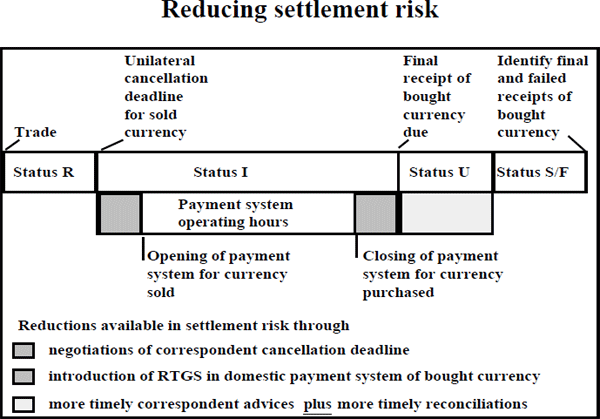
3.8.3 Comparison with the G10 results
Although foreign exchange settlement risk has long been recognised as a major issue, progress in addressing it has been slow. That, however, is starting to change. Some individual institutions have recently made very significant advances in managing and reducing this risk.
It would therefore be unfair to attempt to make too direct a comparison between the results of the 1997 RBA study and that undertaken two years earlier by the G10 central banks. Also, the structures of the respective markets are very different. The G10 central banks did not include the AUD in their surveys and so no direct comparisons can be made for AUD/USD transactions, the most significant currency pair traded in the Australian market.[7] Further, the time zone differences between Australia and the G10 countries work in Australia's favour when settling some currencies and against it when settling others.
That said, the variation between institutions in managing settlement exposures that was identified in the CPSS study applies equally to the participants in the RBA study. Overall, Australian practice does not appear to vary significantly from that of the G10 banks; but there is a sense that Australian institutions are not addressing foreign exchange settlement risk with the same urgency as some of their G10 counterparts.
Footnotes
The survey asked for all foreign exchange settlements to be reported in terms of the original contracted currency. In order to aggregate these amounts, they were converted into a base currency, the AUD, at the average exchange rate prevailing for the month of April. Strictly, such conversions should have been made at the exchange rate applying at the time each individual transaction was entered into, but that would have been a very onerous task for the respondents. Given the relative stability of most currencies during the survey period, the RBA does not believe that the methodology used would lead to a material difference in the analysis. [1]
Vostro account activity is discussed later in Section 4.4 of this report. The daily vostro account settlements from offshore trading were of a similar magnitude to the values settled by Australian banks for their own account. [2]
As noted earlier, despite some indications to the contrary from survey respondents, until the introduction of RTGS, receipts in AUD and NZD cannot be received with finality on value date because interbank settlement is not until the following business day. End-of-day reconciliation of AUD and NZD payments will assist dealers in identifying failed (Status F) payments – possibly averting the classic ‘Herstatt’ scenario – but it cannot bring forward the time when payment instructions which have already been received (Status U payments) are settled and thus become final and irrevocable. [3]
Technically, the aggregate amount at risk will continue to grow until all settlements due on day V have been confirmed with finality. As shown in Annex D, this is not until day V+31 for some currencies. While, for the purpose of this analysis, the average amounts beyond the peak on day V+1 are not material, it should be stressed that they could be if there was a relatively large settlement involving a minor currency. [4]
This is especially true of USD payments, where many of the larger dealers indicated that they could cancel or recall payments well into the New York day. [5]
Japan also has an RTGS system, but this is not currently used extensively for the settlement of foreign exchange transactions in JPY; most of these payments are processed via the FEYCS system. [6]
The same also applies to NZD/USD transactions; a currency pair more actively traded in Australia than either GBP/USD or USD/CHF, but one which is not traded widely in most of the G10 countries. [7]